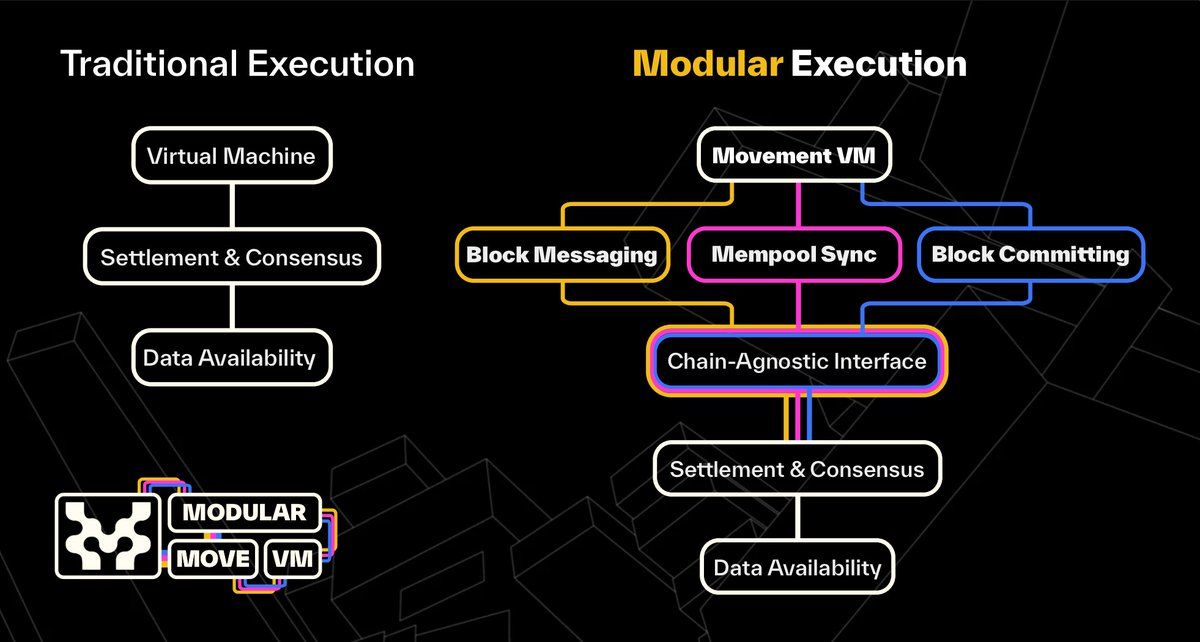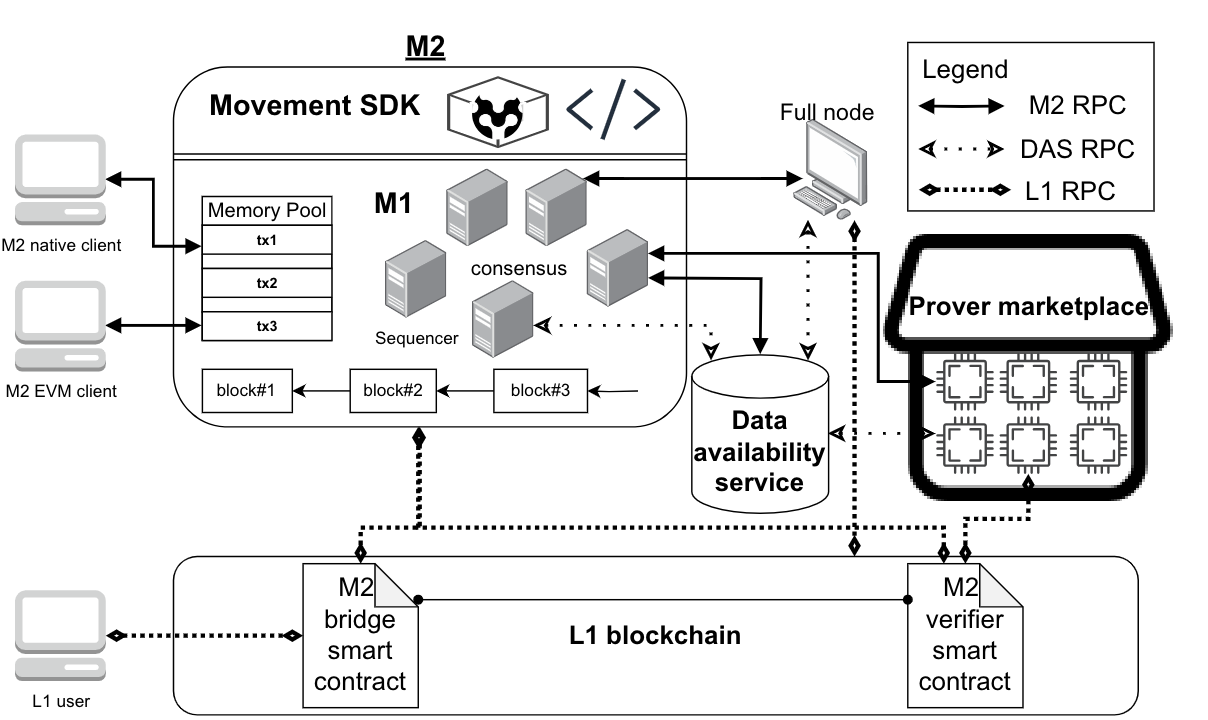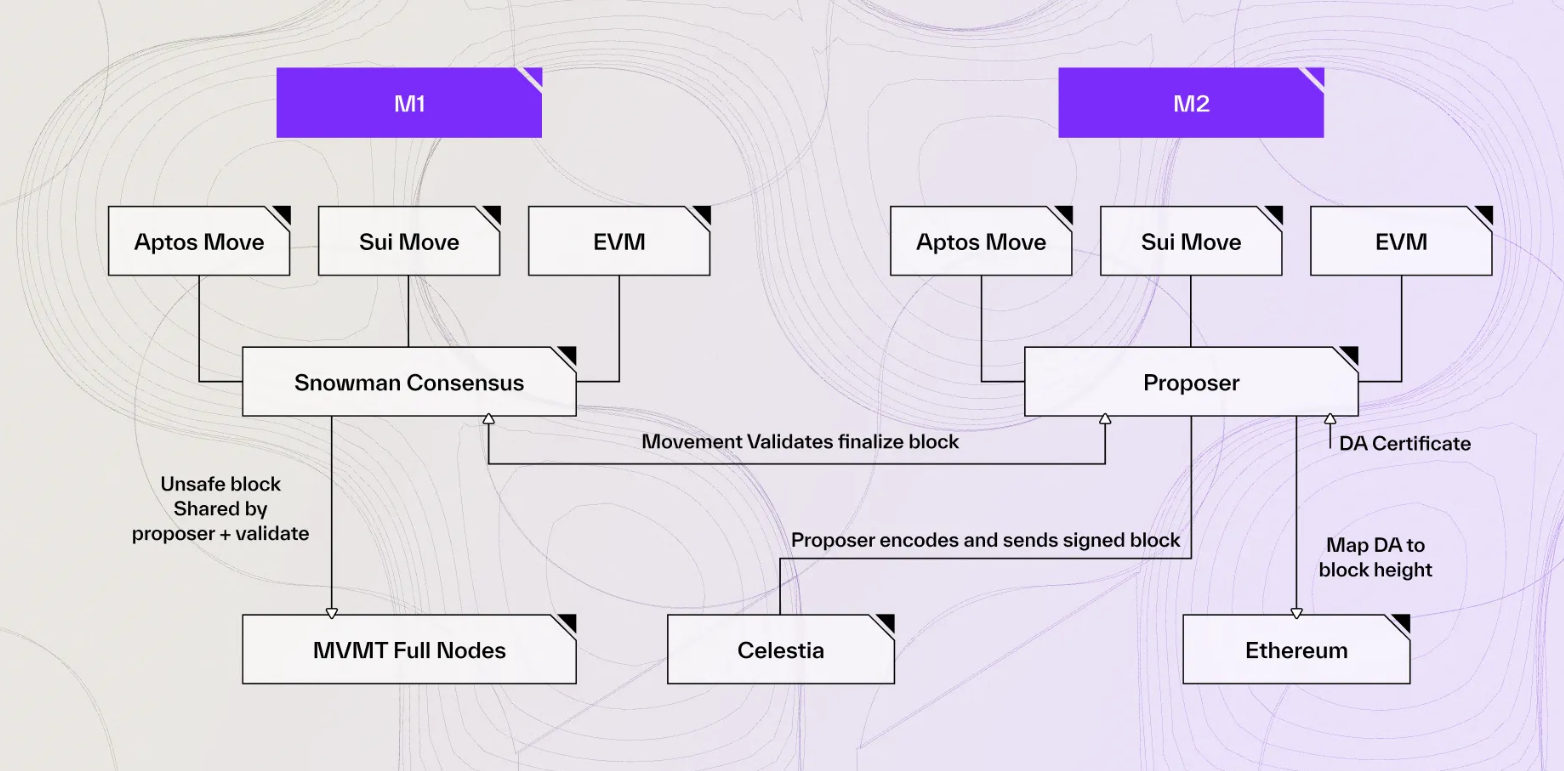Authored by: LFG Labs
Connecting the high-performance architecture of the Move system with the liquidity/user base of the EVM system may well be a perfect fusion of technological narrative and ecological logic.
Imagine if any Solidity developer could directly build/migrate a more secure and efficient DApp on Move with almost zero threshold. Wouldn't that be cool?
In 2019, Libra, which stirred the entire tech industry and quickly withered, may not have expected that after its defeat, Aptos, Sui, Linera, and Movement would successively take over, propelling the new Move-based public chain to a small climax.
Interestingly, unlike Aptos, Sui, and Linera, which are all L1 public chains based on the Move language, the new generation Movement has set its sights on L2—launching the first Ethereum L2 based on the Move language, aiming to leverage the underlying performance and security advantages of Move, and further integrate the ecological advantages of EVM, allowing developers to launch Solidity projects on M2 without the need to write Move code.
As the first fusion solution in the Move-based new public chain from being an "Ethereum killer" to "joining Ethereum," Movement's mechanism design, which applies high-performance architecture at the L2 level and final state security based on the Ethereum mainnet, secured a large financing of $38 million in April.
So, what exactly does Movement aim to achieve, and what kind of magic does it have to attract top investment institutions such as Polychain Capital, Binance Labs, OKX Ventures, and Hack VC?
Movement: Introducing Move into the EVM Ecosystem
Since the programming language reflects the core temperament of a blockchain project, it is necessary to review the intrinsic characteristics of the Move language before delving into what Movement aims to do.
As is well known, Move, developed by Facebook as a new smart contract language, besides being initially applied to Facebook's Libra (Diem) project, is currently mainly adopted in the Web3 products in the market, such as Aptos and Sui, in the new public chain ecosystem.
From the perspective of public chains, Move language can be described as being born for digital assets—compared to blockchain programming languages like Solidity, Move specifically emphasizes the key words "asset security" and "native high performance" in its core logic:
- On the one hand, based on Rust, it is designed as an object-oriented language for writing smart contracts with secure resource management, emphasizing the position of digital assets, enabling developers to more flexibly and securely define and manage digital assets on the chain;
- On the other hand, Move IR, the source code based on Move language, can decouple transaction scripts and modules, separating transaction logic and smart contracts. This allows Move-based public chains to achieve TPS levels of tens of thousands or even 100,000, significantly higher than the performance of EVM-based public chains.
In short, blockchain networks built on Move inherently possess security and high performance advantages superior to Solidity-based public chains, providing a better entry point for new developers to build on-chain applications.
However, for public chains, the technological narrative is often not the main battlefield of competition. The key to public chain competition lies in whether they can attract enough users and funds to enter. This is also the core reason why the term "Ethereum killer" has been rarely mentioned in recent years—compared to Ethereum's continuous application layer innovations, most new public chains suffer from a "ghost town effect," with most networks having very few users and liquidity.
It is for this reason that Movement has chosen a different path, dedicating itself to connecting the security and high performance advantages of the Move-based smart contracts with the liquidity and user base advantages of the EVM system, aiming to combine the respective advantages of the two through the idea of "introducing Move into Ethereum."
For example, the M1 and M2 public chain architecture under Movement naturally possesses the advantage of efficient transaction processing, while also integrating the Ethereum Virtual Machine (EVM), allowing developers to launch and introduce mature DApps from the EVM system on M2 without the need to write Move code.
In other words, Movement automatically converts Solidity scripts into operation codes that Move can understand, enabling Move to achieve interoperability with Ethereum and other EVM networks.
Therefore, rather than saying that Movement is introducing Move into the EVM ecosystem, it is more accurate to say that it is incorporating the funds and users of the EVM ecosystem into the Movement Labs stack and the broader Move ecosystem, ultimately attracting the flow of the EVM ecosystem to build a more secure and efficient blockchain system.
Modular Development Kit Movement SDK
The main development tool that realizes the core vision of "introducing Move into Ethereum" is the Movement SDK.
As a modular development kit, it mainly consists of three core components: MoveVM, Fractal, and custom adapters (Adaptors) for the sorter network and DA services.
MoveVM: Secure and Efficient Execution Environment
First and foremost, as the core of the Movement SDK, MoveVM primarily provides a secure and efficient, resource-oriented execution environment for smart contracts.
This also enables the Movement SDK to execute complex smart contracts and manage digital assets, making it an indispensable part of the M2 network (as detailed in the following section). Therefore, MoveVM is also a key support for the M2 network to achieve ultra-high transaction throughput and extremely fast response speed. Its main features include:
- Resource-oriented programming: MoveVM treats assets as tangible, non-replicable resources, ensuring a higher level of security and integrity in asset management;
- Strict security guarantees: By using bytecode verification processes, MoveVM ensures that all executed code complies with strict security protocols, minimizing vulnerabilities and enhancing the overall robustness of the blockchain system;
- Efficient asset management: It provides a controlled environment for precise management of digital assets, ensuring the highest fidelity and reliability in transaction execution;
- Type safety and formal verification: MoveVM emphasizes type safety, capturing errors at compile time with a strict type system. Combined with formal verification methods, it ensures that smart contracts adhere to specified properties and security standards, reducing the risk of errors and vulnerabilities;
- Isolation and encapsulation: Assets and code in MoveVM are encapsulated in modules, implementing strict access control and isolation. This encapsulation prevents unauthorized access and interaction, ensuring that each module runs within its defined parameter range, thereby enhancing the overall security and integrity of the system;
- Bytecode verification: MoveVM employs a comprehensive bytecode verification process to carefully inspect smart contracts before execution, ensuring that all contracts comply with the platform's security and correctness standards, significantly reducing the risk of executing malicious or defective code.

It is worth noting that Movement's MoveVM utilizes parallel processing technology and modular architecture. The former optimizes the order and priority of transactions in the memory pool through algorithms, reducing transaction congestion and latency through parallel processing.
The latter aims to extend the functionality of the original MoveVM to external environments (such as EVM), creating a multi-functional virtual machine designed to encompass a wider interoperable blockchain ecosystem.
Just a couple of days ago, senior Move engineer @artoriatech publicly tweeted about the "fragmentation" issue currently faced by the Move ecosystem, stating that "developers face significant resistance when transitioning from one Move chain to another":
For example, with Sui Move and Aptos Move, each chain is an isolated ecosystem with its unique VM and toolkits, with significant differences and continued growth as new features are released, to the point where they are almost like different languages, and there are no projects attempting to reduce these differences.
On the other hand, the modular MoveVM of Movement is designed as a multi-functional virtual machine, aiming to be fully compatible with EVM and other Move ecosystems—currently supporting the deployment of Aptos and EVM code, and soon to cover the Sui ecosystem as well.
This means that DApps from EVM ecosystems such as Aptos and Ethereum can be deployed within 10 minutes—developers do not need to learn Move separately, they just need to keep their code in the existing language architecture, such as Solidity, to achieve parallel deployment.
Fractal: Bridging Solidity and MoveVM
Fractal is essentially a compiler that enables Solidity smart contracts to execute in the MoveVM environment, seamlessly connecting the secure frameworks of Solidity and Move, allowing developers to deploy their Solidity contracts on MoveVM (M2 network).
The benefits of this are self-evident—developers can enjoy the flexibility of Solidity while leveraging the security and high-performance advantages of Move to address some inherent issues in Solidity.
The compilation process of Fractal mainly consists of the following 5 steps:
- Tokenization and Parsing: This process first breaks down Solidity scripts into tokens representing basic script elements (such as variables, functions, and control structures), parsing these tokens involves analyzing the syntax structure of Solidity code and organizing the elements into an Abstract Syntax Tree (AST) that describes the logic and organizational flow of the code.
- Abstract Syntax Tree (AST): The AST is a tree representation of the syntax structure of Solidity code, detailing the hierarchical structure of operations and the relationships between different code segments.
- Intermediate Language (IL): After building the AST, the code is transformed into an intermediate language (IL) to bridge the gap between high-level Solidity code and the low-level instructions required for execution.
- MoveVM Operation Codes: The IL is then compiled into MoveVM's operation codes, which are the basic instructions understood and executed by the virtual machine, indicating specific operations that MoveVM should perform.
- MoveVM Bytecode: In the final stage, the operation codes are transformed into MoveVM bytecode, which is the executable binary representation of the program, compiled entirely based on the original Solidity script and prepared to run in the secure and resource-oriented environment of MoveVM.
According to the official blog, Fractal is still in the development stage, undergoing thorough testing and enhancements to expand its functionality beyond the existing features.
Custom Adaptors
Custom Adaptors are the final core component of the Movement SDK (essentially the M1 architecture mentioned below), aiming to provide seamless integration with the sorter network and Data Availability (DA) services:
- Data Availability Services (DA): The Movement SDK integrates with DA services, enabling DA services to run directly on L1 or as standalone dedicated DA services, ensuring reliable access to transaction data.
- Support for Danksharding: To align with Ethereum's roadmap, the Movement SDK reserves the ability to collaborate with exclusive DA service providers, including Celestia and EigenDA—providing guaranteed data availability.
- Validator Node Management and Sorter Integration Services: The custom adaptors of the Movement SDK are also responsible for strategic management and reconfiguration of validator nodes, while enhancing the blockchain's defense against witch attacks through integration with consensus mechanisms such as Snowman and Proof of Stake (PoS).
- Cross-DA Layer Compatibility: These custom adaptors can also support various DA layers, including Ethereum-4844 and several sovereign DA solutions such as Celestia, EigenDA, and Avail, ensuring that users can choose the DA layer that best suits their application needs.
Overall, the Movement SDK provides a comprehensive development suite, including a runtime environment for deploying and testing smart contracts, a compiler, and adaptors, aiming to simplify the development process and make it easier for developers, especially Solidity developers, to build, test, and optimize DApps based on the Move language.
"M1+M2" Public Chain Architecture
Based on the Movement SDK, Movement Labs has developed a public chain architecture including M1 and M2.
M1 is designed as a community-first network, capable of achieving extremely high transaction throughput and instant finality to provide decentralized sorter networks and consensus layers; while M2 is a ZK-Rollup L2 solution based on M1 and Ethereum (also supporting Sui Move and Aptos Move), enabling compatibility for DApps with Ethereum.
M1: Decentralized Sorter Network and Consensus Layer
M1 is officially defined as a "community-first blockchain" based on Move, providing as high TPS as possible through instant finality, modular customization, and aiming to support complex transactions and smart contract functionality with the high security and customizability of the Move language, while ensuring platform reliability and user-friendliness.
However, according to current public information, it is gradually transitioning into a decentralized sorter network, playing the role of "shared sorter" and "consensus layer" components within the entire ecosystem of Movement Labs and any blockchain network, in order to achieve interoperability between Move and other networks, supporting various applications and services.
It is worth noting that, as M1 adopts an improved Snowman consensus mechanism, it allows nodes to reach consensus by mimicking social interactions (i.e., "chatter" between nodes), naturally supporting larger-scale node participation and faster consensus speed to achieve high throughput and efficient transaction sorting.
Based on this, M1 acts as the PoS sorter network and consensus layer for M2, ensuring the security of the M2 network through staking and providing an efficient consensus mechanism. To become a sorter in the M1 network, one needs to stake MOVE tokens and prevent malicious activities through the Slash mechanism, enhancing the security and reliability of the network.

As a PoS sorter network for M2, M1 utilizes Data Availability (DA) services and the Prover Marketplace to ensure the correctness, accessibility, and verifiability of transactions.
M2: ZK-Rollup L2 based on M1 and Ethereum
M2 can be seen as the "mainnet" of the Movement ecosystem, introducing a ZK-Rollup architecture based on Move, consisting of MoveVM, Fractal, and M1, responsible for deploying specific DApp applications.
The term "based on Move ZK-Rollup architecture" is used because M2 plans to use zero-knowledge proofs to enhance privacy and security (i.e., zk-Move technology), giving M2 not only advantages in processing speed and cost-effectiveness but also unique advantages in privacy protection.
With MoveVM and Fractal, M2 can execute standard EVM smart contracts and support smart contracts written in Move language (Aptos Move, Sui Move). By utilizing the parallelization model of Move language and Sui, it can provide high throughput and low-latency services for EVM transactions.
This means that developers using languages like Solidity can easily launch secure, high-performance, and high-throughput MoveVM Rollup applications, directly leveraging the native advantages of the Move language.

Finally, all transactions executed on M2 will be sent back to Ethereum through the M1 sorter network, and the validity of the transactions will be proven through the Prover Marketplace's zk-provers network, with the results of the ZK proofs being published on the Ethereum mainnet and the transaction details being released to Celestia, achieving data state synchronization between the two:
Using Blobstream technology, the modular data availability layer of Celestia can be transmitted to Ethereum, and developers can create high-throughput Ethereum L2 by integrating Blobstream, similar to developing smart contracts.
In simple terms, M1 is responsible for the consensus layer and transaction sorting, M2 is responsible for Solidity-Move conversion and transaction execution, and Celestia/Ethereum is responsible for final data availability and state security, maximizing the integration of Move's high performance, security, and EVM's user and traffic advantages.
Conclusion
Beyond the technical narrative, the ability to rapidly build a large and thriving ecosystem from scratch is crucial.
The tools developed by Movement Labs, such as the Movement SDK, the messaging infrastructure Hyperlane, and the shared sorter (M1), are all aimed at providing developers with the necessary resources to easily build and deploy applications based on Move.
According to official disclosures, the runtime environment Move Stack operated by Movement Labs will begin testing this summer. As an execution layer framework, it plans to be compatible with many Rollup frameworks from companies such as Optimism, Polygon, and Arbitrum.
From this perspective, the combination of M1, M2, and Move Stack suites may give rise to a universal MoveVM cosmos covering the Solidity ecosystem and the Aptos Move, Sui Move ecosystems, thereby enabling other protocols not based on Move to leverage Move's functionality and expanding the influence of the Move language.
This will allow any developer to meet the demands of future high-performance DApps in a decentralized and secure manner, solving scalability and performance issues in asset transfer and exchange processes, reaching a commercially viable level.
Although Movement's development is still in its early stages, top VC firms have undoubtedly seen the potential opportunity of integrating Move and Solidity and have begun to position themselves to seek new solutions to end the "scalability bottleneck" and "high-performance ghost town" extremes.
If all goes well, this combination may lay the foundation for a new wave of use cases, new users, and ultimately the growth of the universal Move-Solidity ecosystem. We await with anticipation.
免责声明:本文章仅代表作者个人观点,不代表本平台的立场和观点。本文章仅供信息分享,不构成对任何人的任何投资建议。用户与作者之间的任何争议,与本平台无关。如网页中刊载的文章或图片涉及侵权,请提供相关的权利证明和身份证明发送邮件到support@aicoin.com,本平台相关工作人员将会进行核查。




